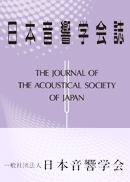All issues

Volume 30, Issue 12
Displaying 1-10 of 10 articles from this issue
- |<
- <
- 1
- >
- >|
-
Hajime Miura, Eiichi MatsuiArticle type: Article
1974Volume 30Issue 12 Pages 639-646
Published: December 01, 1974
Released on J-STAGE: June 02, 2017
JOURNAL FREE ACCESSA theoretical study is made of the corrections for coupler calibration of laboratory standard microphones. In the analysis, the effect of wave motion in a coupler is discussed, taking into consideration the interaction between the microphone diaphragm and the medium. A new method of solving the wave equations, called the infinite-matrix method, is presented in this paper. A coupler is divided into several right circular cylinders and two diaphragms. Each part can easily be solved in general form as an expansion into orthogonal functions. After arranging these solutions in the form of matrix equations with unknown variables, we obtain a system of simultaneous matrix equations by connecting the solutions together. Exact solutions of the wave motion correcting as well as the transmission characteristics for both type 20 cc and 3cc couplers are presented. It is also confirmed that numerical results for the case of the transmission characteristics of the 20cc coupler are rapidly convergent.View full abstractDownload PDF (929K) -
Junichi FujiwaraArticle type: Article
1974Volume 30Issue 12 Pages 647-652
Published: December 01, 1974
Released on J-STAGE: June 02, 2017
JOURNAL FREE ACCESSIn this paper a number of small size transducersare mounted on a hemisphere so as to obtain a desireddirectivity. The actual directivity Parameter is compared with the desired one at a finite number of points, the best approximation is obtained by minimizing themaximum of the difference. The necessary conditionfor a distribution to give the minimum is formulated, and an iterative algorithm is presented which hopefully converges to a local minimum. All illustrativeexample is given to demonstrate the effectiveness ofthis approach.View full abstractDownload PDF (630K) -
Yoshinori NiiArticle type: Article
1974Volume 30Issue 12 Pages 653-661
Published: December 01, 1974
Released on J-STAGE: June 02, 2017
JOURNAL FREE ACCESS -
Masanao Ebata, Toshio Sone, Tadamoto NimuraArticle type: Article
1974Volume 30Issue 12 Pages 662-669
Published: December 01, 1974
Released on J-STAGE: June 02, 2017
JOURNAL FREE ACCESSSeveral experiments dealing with temporal summation characteristics in auditory systems were carried by means of jittered pulse trains, and the results are as follows:(1)The audible thresholds of the pulse trains were determined as a function of the pulse density. The results, as shown in Fig. 3, indicate that for repetition rates lower than 10pps there is little change in threshold, and that for the higher rates the threshold becomes lower with increasing repetition rate. The slopes of the threshold curves increase to -3dB/oct. for repetitions rate in the range of 125-250 pps. this characteristic is attributable to temporal integrations in the auditory system. Furthermore, this phenomenon was observed at at about 2 kpps, so it should be considered that there is a temporal summation function in the low stage of the auditory system. The time constant of integration, estimated from these data, is about 30 msec. (2)A similar phenomenon based on temporal summation was observed for the loudness of jittered pulse trains. That is, a pulse train with a higher pulse repetition rate is louder than one with a lower rate. Although this phenomenon is distinct for weak stimuli, it gradually disappears as the stimulating sound becomes more intense(Fig. 5). The mechanism causing these phenomenon is discussed by means of a firing model of the neuron bahased on neurophysilogical evidence and good agreement is obtained. (3)Related to the temporal loudness summation, the effect of loudness on the discrimination on duration was examined. The results are that the duration of sound is perceived based on loudness for durations shorter than 50 msec. but for longer durations no influence of loudness on the perception of durations was observed (Fig. 10, 11). This result was comformed by means of a sound with interaural time difference and light stimuli. That is, in order that the information about the loudness be excluded from the stimuli, interaural time differences and time difference of lighting were used as stimuli and both discriminations were determined. The results that discriminations becomes constant at about 10 msec. for time differences shorter than 50 msec. (Fig. 12, 13). By contract, the discrimination of duration becomes less with the decrease of duration(Fig. 11). these results show that the duration of sound is perceived through integration circuits with a time constant of about 30 msec.View full abstractDownload PDF (846K) -
Yoshinari KanamoriArticle type: Article
1974Volume 30Issue 12 Pages 670-672
Published: December 01, 1974
Released on J-STAGE: June 02, 2017
JOURNAL FREE ACCESSDownload PDF (209K) -
Yoshinari Kanamori, Ken'iti KidoArticle type: Article
1974Volume 30Issue 12 Pages 673-674
Published: December 01, 1974
Released on J-STAGE: June 02, 2017
JOURNAL FREE ACCESSDownload PDF (197K) -
Yoshio Yamasaki, Takeshi ItowArticle type: Article
1974Volume 30Issue 12 Pages 675-676
Published: December 01, 1974
Released on J-STAGE: June 02, 2017
JOURNAL FREE ACCESSDownload PDF (197K) -
Schuichi Itabashi, Schoichi YokoyamaArticle type: Article
1974Volume 30Issue 12 Pages 677-678
Published: December 01, 1974
Released on J-STAGE: June 02, 2017
JOURNAL FREE ACCESSDownload PDF (158K) -
Shozo HattoriArticle type: Article
1974Volume 30Issue 12 Pages 679-681
Published: December 01, 1974
Released on J-STAGE: June 02, 2017
JOURNAL FREE ACCESSDownload PDF (387K) -
Article type: Article
1974Volume 30Issue 12 Pages 682-700
Published: December 01, 1974
Released on J-STAGE: June 02, 2017
JOURNAL FREE ACCESSDownload PDF (2436K)
- |<
- <
- 1
- >
- >|